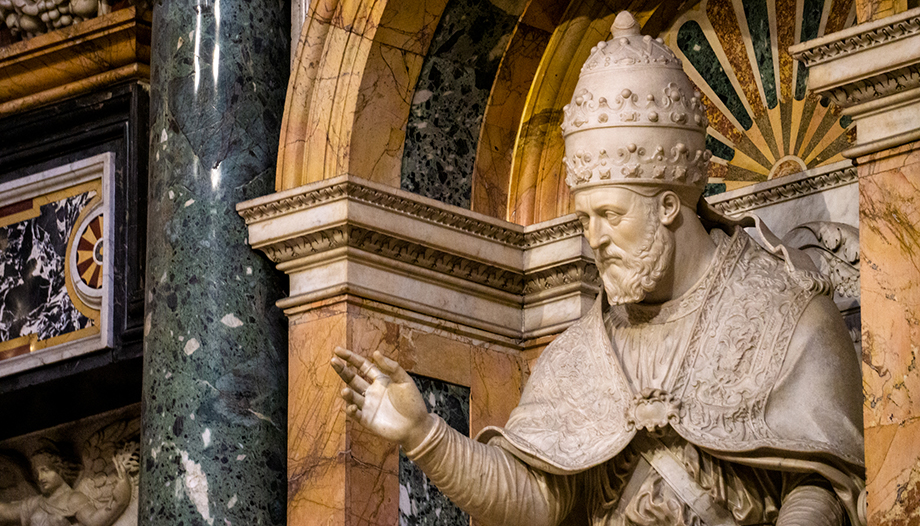In a recent interview with the Mexican television channel N+, Francis announced that he was preparing his tomb in the Basilica of Santa Maria Maggiore.
A surprising announcement, but nothing extraordinary: since 1914 all the Popes have been buried in the Vatican grottoes (although some of them - after their canonization - were later moved inside the Vatican Basilica. The last in order of time: St. Pius X, St. John XXIII and St. John Paul II.
Francisco and Santa María la Mayor
The reason for this choice is to be sought in Francis' special bond with the Basilica of Santa Maria Maggiore, even before he became Pope.
It was also there that St. Ignatius of Loyola, founder of the Jesuits, the religious order from which Bergoglio comes, celebrated his first Mass on Christmas 1538.
Francis went to the same church the morning after the night of the Conclave, on March 14, 2013, to dedicate his pontificate to Mary. He returns there before and after every trip abroad, to pray before the icon of the Virgin "Salus populi romani", salvation of the Roman people, and he has addressed her several times, for example during the pandemic.
On December 8, 2023, as he does every year, the Pope went to the Marian basilica, before paying the traditional homage to the Immaculate Conception in Piazza di Spagna, placing a golden rose before the icon of the Virgin Mary.
Pope Francis' decision to be buried in the Basilica of Santa Maria Maggiore, although an unusual event, is nevertheless unprecedented.
It must be said that Bergoglio is, in fact, the first pontiff in more than 120 years to choose to be buried outside St. Peter's. The last was Leo XIII, buried in St. John Lateran, the cathedral of the bishop of Rome, in 1903. The last was Leo XIII, buried in St. John Lateran, the cathedral of the bishop of Rome, in 1903.
Since when are Popes buried in St. Peter's?
The tradition of burying Popes in St. Peter's Basilica dates back to the fourth century.
However, over the centuries, some pontiffs have chosen to be buried elsewhere for a variety of reasons: personal choices or for religious, sentimental or political reasons.
In some circumstances, however, burial outside the Vatican was imposed for historical or political reasons. For example, Pope Gregory XII, who died in 1415, was buried in the cathedral of San Flaviano in Recanati, his hometown.
Pope Pius IX, on the other hand, who died in 1878, was buried in the Basilica of St. Lawrence Outside the Walls in Rome, because he was particularly attached to that place.
Popes outside St. Peter's
Also outside St. Peter's are Pius IX (1878, St. Lawrence Outside the Walls), Urban V (1370, Abbey of St. Victor, Marseille), Clement VII (1534, Santa Maria sopra Minerva, Rome), Damaso II (1048, St. Lawrence Outside the Walls), Ilario (468, St. Lawrence Outside the Walls), Sisto III (440, St. Lawrence Outside the Walls), Zosimo (418, St. Lawrence Outside the Walls).
In these last two centuries, this is the situation of the burials, in chronological order: St. Pius X, St. John XXIII and St. John Paul II in St. Peter's Basilica. Leo XIII (1878-1903), buried in the Basilica of St. John Lateran, the same that houses the remains of 22 popes.
Leo XIII's predecessor, Blessed Pius IX (1846-1878) is also buried outside the Vatican: his tomb is in the Basilica of San Lorenzo outside the walls.
St. Peter's Basilica (including the Vatican Grottoes) houses the tombs of about ninety popes, while in the Basilica of St. Paul Outside the Walls (where you can admire in the main nave the portraits representing all the Popes who succeeded St. Peter), only two Popes are buried: St. Felix III (483-492), who had a family tomb there, and John XIII (965-972) who expressly requested it in his will.
Clement XIV (1769-1774) is buried in the Basilica of Saints XII Apostles, while Benedict XIII (1724-1730) rests in the Basilica of Santa Maria sobra Minerva.
In the Basilica of Santa Maria Maggiore, Pope Francis will meet five of his predecessors: Pius V (1566-1572), Sisto V (1585-1590), Clement XIII (1758-1769), Paul V (1605-1621) and Clement IX (1667-1669).









